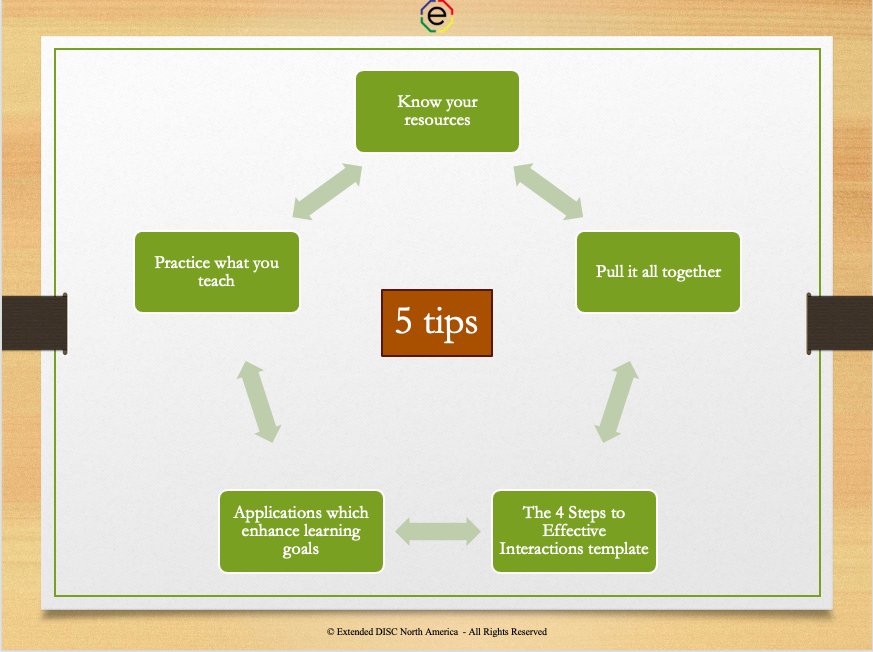Try these 5 tips to help you feel more confident and ready to start your first DISC session!
Where to start? Start with confidence!
Confidence! You've got this!

You do a better job when you feel confident. Of course, we are always trying to do our best but sometimes things don't go as planned. Give yourself some grace.
Preparation is the pathway to confidence, but it should not be at the expense of your joy. But, just as DISC teaches you, how much and what type of preparation depends on your own facilitation style. You prepare so you feel your most confident self; which then allows you to go in and be your best self. You already have a great start when delivering DISC because people see it as a fun experience and an opportunity to focus on themselves!
We will do our share to help you feel more confident through tips and resources we've created for you!
Tips to get you started

We'll start with getting to know your resources. Create a mental checklist of the items you have and the items you need. This will help you see your end goal and possibly narrow it down to the most pertinent resources.
 Next is pulling it all together. Think about the content and context in which you will be doing your session. Examples include setting your time goals and estimating group size. Will it be virtual or classroom? Is it a general DISC session or a leadership session? What games and activities are you planning to use to keep your audience connected to you? Get to know your technology and support materials.
Next is pulling it all together. Think about the content and context in which you will be doing your session. Examples include setting your time goals and estimating group size. Will it be virtual or classroom? Is it a general DISC session or a leadership session? What games and activities are you planning to use to keep your audience connected to you? Get to know your technology and support materials.
 Don't reinvent the wheel the first time or each time. We have designed the 4 Steps to Effective Interactions as a template for delivering your DISC sessions. One extra tip is to start with the 4 Steps to Effective Communication: Self-Development Guide. It's a great trainer reference guide. It helps you tell your story in a simple and effective way; bringing it to a level your participants can understand when hearing it for the first time.
Don't reinvent the wheel the first time or each time. We have designed the 4 Steps to Effective Interactions as a template for delivering your DISC sessions. One extra tip is to start with the 4 Steps to Effective Communication: Self-Development Guide. It's a great trainer reference guide. It helps you tell your story in a simple and effective way; bringing it to a level your participants can understand when hearing it for the first time.
Building on games and activities, chose the ones that best support your overall goals. Application is the most important take-away in your DISC session; getting people in a position they can start incorporating their learning into their real world. Application is built into the 4 Steps to Effective Interactions template. Exercises that connect the 2 worlds and get learners to start practicing awareness and adjustments is the greatest gift you can give them. We have a list of activities to help you get started.
Final tip
 The fifth tip is to "practice what you teach" by practicing your own 4 Steps to Effective Interactions. Own and be confident in your own style. Know your behavioral challenges so you can better practice and develop them.
The fifth tip is to "practice what you teach" by practicing your own 4 Steps to Effective Interactions. Own and be confident in your own style. Know your behavioral challenges so you can better practice and develop them.
Identify the styles of your audience ahead of time by running a Team Name Map; they don't even need to be an intact team. You'll know to slow down if you have a more Reserved group or build in more time to chat if you have a group with more I-styles. When you are in your live session, be aware of what works and if you need to make any adjustments. In doing so, your audience will be more receptive and motivated to hear what you have to say.
Finally, be kind to yourself. You will be way harder on yourself than your learners will ever be. As trainers, we like to prompt our learners from the get go that technology blips can happen. We hope these tips help you feel more confident. You've got this!

